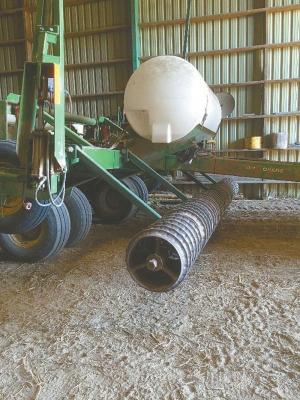2017 - Volume #41, Issue #2, Page #29
[ Sample Stories From This Issue | List of All Stories In This Issue | Print this story
| Read this issue]
Planter-Mounted Packer Made From Old Culti-Packer
 |
“I used it last year for the first time, and it did everything I wanted it to do,” says Robson. “It does a great job of packing down small stones and rootballs, keeping them from jamming between the planter’s gauge wheels. I only plant about 150 acres of corn and beans each year, so I couldn’t justify the money for a new packer.”
His planter is actually a 6-row, 30-in. model with five inter-row units for planting 15-in. soybean rows. “The inter-row units on newer planters can be raised and locked up out of the way, but they can’t on my old planter,” says Robson. “As a result, there are only small gaps between the gauge wheels, where stones and corn rootballs can easily jam up. I could have bought narrower replacement gauge wheels to widen the gaps, but I couldn’t justify spending the money.
“The lack of a planter-mounted packer also created problems when planting beans into corn with our planter. After finishing planting, we tried to make a pass with our 12-ft. pull-type packer. However, there was so much crop residue that the driver could hardly tell where the planter had been and had a hard time figuring out where to make the next pass.
“Then, 2 years ago, we forgot to use the packer on a small field of planted soybeans, and that fall, we had a lot of trouble keeping stones out of the combine. We knew we had to do something.”
The 12-ft. wide culti-packer came with two sets of rollers with a row of shanks between them. Robson unbolted the rollers from the frame. His planter is 15 ft. wide, so he cut the roller shafts down to make two 7 1/2-ft. shafts, one on each side of the planter tongue, and then remounted the rollers and bearings. He used 1 1/2-in. tubing inside 2-in. tubing to make four mounting arms which are used to attach the packer to the planter toolbar.
“The two different sizes of tubing together make the mounting arms much stronger than just one tube,” says Robson.
To attach the mounting arms to the rollers, he drilled holes into 2-in. wide by 1/2-in. thick metal brackets and mounted the bearing hangers in them then welded the brackets onto the shafts. The back end of each mounting arm is hinged to the planter frame, with a bolt serving as the hinge point.
He also used channel iron to make “stops” for each mounting arm that cause the rollers to automatically lift off the ground as the planter is raised.
Robson says his only expense was about $30 for the hinge material - thick-walled round steel tubing.
He says the front-mounted packer has another big advantage - the planter’s weight is now much better balanced. “Even with a full liquid fertilizer tank, my planter used to be back heavy, which made it difficult to unhook from the tractor with the planter locked in the up position. Now it always stays level whenever it’s not hooked up,” notes Robson.
Contact: FARM SHOW Followup, Andy Robson, 1611 Zion Line, Millbrook, Ontario, Canada L0A 1G0 (ph 705-932-3176; atrobson@nexicom.net).

Click here to download page story appeared in.

Click here to read entire issue
To read the rest of this story, download this issue below or click here to register with your account number.




